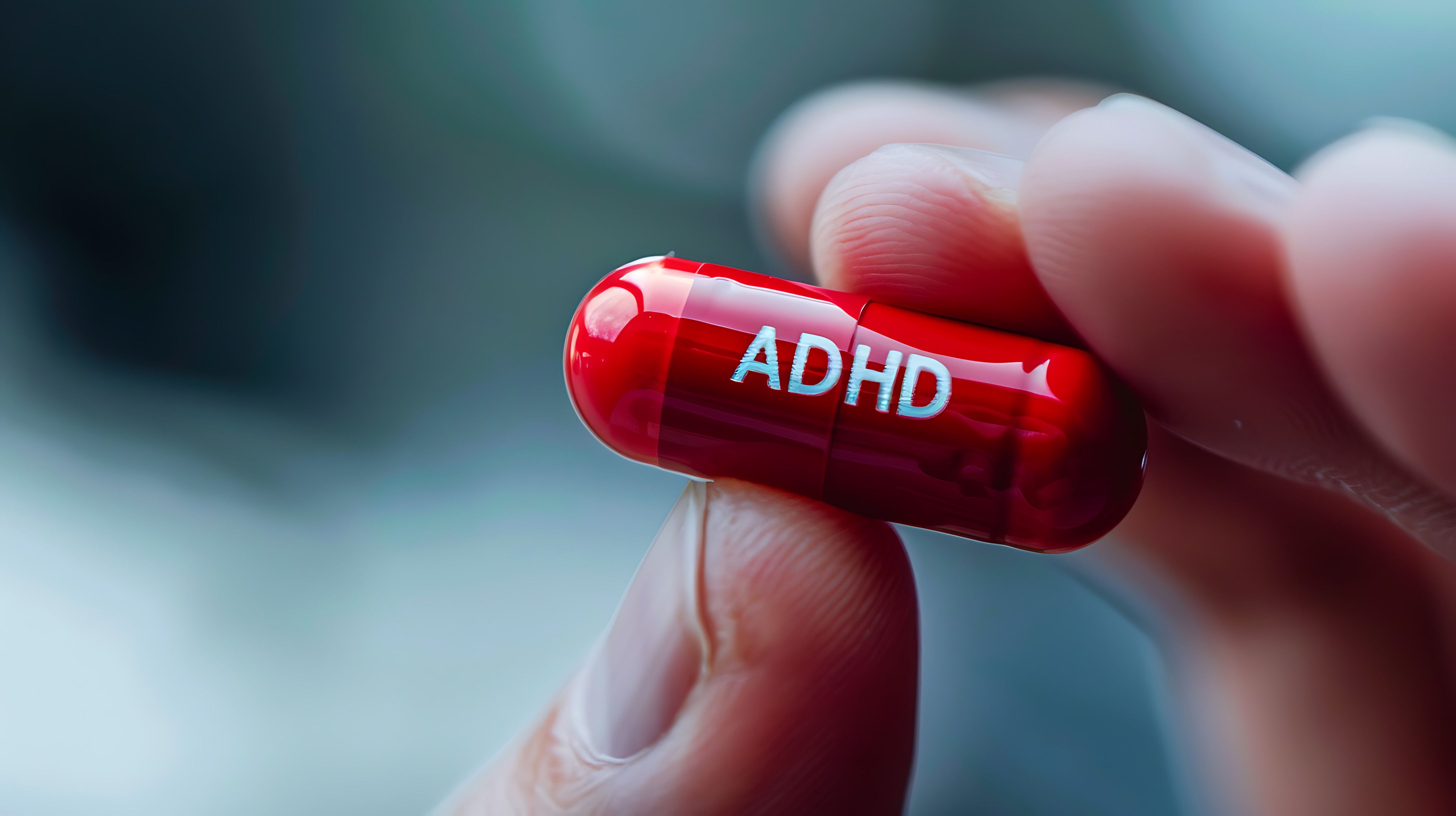Publication
Article
Psychiatric Times
Problems of Overdiagnosis and Overprescribing in ADHD
Author(s):
Doubt and confusion as to where ADHD fits into the general spectrum of illness further feeds the general perception that ADHD is a socially constructed disorder rather than a valid neurobiological disorder
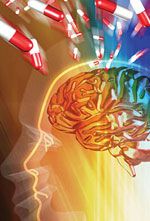
ADHD is the most extensively studied pediatric mental health disorder, yet controversy and public debate over the diagnosis and medication treatment of the disorder continue to exist.1 Questions and concerns are raised by professionals, media commentators, and the public about the possibility of overdiagnosis of ADHD in youths and the possibility of overprescribing stimulant medications. Fueled by sensational media coverage that emphasizes controversy over rationality, the debate can at times become quite heated, leading to a general public assumption that ADHD is overdiagnosed and that stimulant drugs are overused and overprescribed in children and adolescents with and without ADHD.2
Trends in ADHD diagnosis and stimulant treatment
ADHD is a psychiatric disorder with a long history. It was first described by the English pediatrician Sir George Frederick Still in 1902, and initial diagnostic classifications emphasized the symptoms of hyperactivity and impulsivity. The diagnostic terms used to describe children with this disorder changed frequently in the 20th century. With the introduction of DSM-III in 1980, the symptom of inattention gained ascendancy and the condition was officially listed as attention-deficit disorder. DSM-IV contains the diagnosis of ADHD with 3 subtypes: combined, inattentive, and hyperactive-impulsive. Further modifications of the criteria for the disorder are expected when DSM-5 is introduced.
Before 1970, the diagnosis of ADHD was relatively rare for schoolchildren and almost nonexistent for adolescents and adults. Between 1980 and 2007, there was an almost 8-fold increase of ADHD prevalence in the United States compared with rates of 40 years ago. Considering the prevalence of school-administered stimulants as synonymous with the prevalence of ADHD, Safer and colleagues3,4 estimated the prevalence of ADHD in American schoolchildren as 1% in the 1970s, 3% to 5% in the 1980s, and 4% to 5% in the mid to late 1990s. In 2007, using data from the National Survey of Children’s Health, Visser and colleagues5 reported that 7.8% of youths aged 4 to 17 years had a diagnosis of ADHD and 4.3% reported current use of a medication for the disorder.
The rise in prevalence stemmed from a complex confluence of forces and events that came together in the first half of the 1990s and permitted a dramatic expansion of ADHD diagnosis and treatment.6 The growing political strength of children’s welfare advocates and the mental health consumer’s movement associated with decreasing stigma resulted in changes to federally funded special education programs. The Individuals with Disabilities Education Act recognized ADHD as a disability, and children with ADHD became eligible for school accommodations.
Beginning in the 1990s, Congress expanded eligibility criteria for Medicaid, especially for children. This fueled a rapid increase in coverage for psychotropic medications, including stimulants.6 At the same time, scientific knowledge about the longitudinal course of ADHD and its lifetime morbidity, heritability, and neurobiology was rapidly increasing, This provided empiric evidence as well as a scientific and neurobiological rationale for medication intervention.7,8 Also, the managed care psychiatric carve-out health insurance industry sought to rein in the costs associated with psychiatric illness and supported pharmacological interventions for complex psychiatric disorders, including pediatric disorders.
In 1997, Congress passed the FDA Modernization Act, which encouraged the pharmaceutical industry to develop and test drugs for children by extending patent exclusivity. This resulted in a dramatic increase in randomized controlled trials in children that involved stimulant compounds for ADHD and further supported an evidence-based rationale for medication intervention in ADHD. As a result, the prescribing of stimulants for children with ADHD increased 4-fold between 1987 and 1996, with a further increase of 9.5% between 2000 and 2005. Currently, slightly more than 4% of children and adolescents in the United States use ADHD medications.5,9
Doubt and confusion as to where this disorder fits into the general spectrum of illness further feeds the general perception that ADHD is a socially constructed disorder rather than a valid neurobiological disorder.
The rise in stimulant prescribing for youths must be taken in context. Between 1990 and 2005 there was a rapid rise in pediatric prescriptions for many psychiatric medications-not only stimulants. There was a 5-fold increase for antipsychotics between 1993 and 2002, and a 3-fold increase for antidepressants between 1997 and 2002.10,11 Thus, the rise in stimulant prescribing for pediatric ADHD was only part of a larger shift to an emphasis on medication interventions for the treatment of children with early-onset and complex behavioral and mental health disorders.
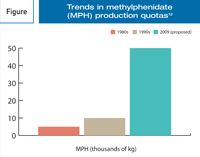
Stimulant overprescribing
Public perception of stimulant overprescribing is driven by concerns over the rapid rise in the amount of available stimulants produced in the United States over the past 3 decades. For sale stimulant production quotas are published yearly by the Drug Enforcement Administration.12 The rapid rise in the production quota of for-sale methylphenidate (excluding amphetamine) is seen in the Figure. With the production of more stimulants every year, worries about the increased availability of stimulants for abuse and diversion rise as well. Rising production rates are cited as proof of stimulant overprescribing by physicians and indirect evidence of the overdiagnosis of ADHD among children.2
The extant scientific research suggests a much more complicated and nuanced picture of stimulant prescribing. Comparisons of the prevalence of ADHD among youths aged 4 to 17 years (7.8%) with stimulant prescription rates of between 4.3% and 4.4% do not support the idea of a culture of permissive stimulant overprescribing.5,9 Moreover, recent data from the National Health and Nutrition Examination Survey, a nationally representative probability sample of children aged 8 to 15 years living in the community, indicated an ADHD prevalence rate of 7.8%. However, only 48% of the ADHD sample had received any mental health care over the past 12 months.13
Clearly, not every person who meets criteria for ADHD is in need of a medication intervention. A discrepancy between ADHD prevalence and rates of stimulant prescriptions does not automatically prove that medications are underprescribed in the population. Nor do data support a conclusion that an epidemic of ADHD med-ication overprescribing is occurring.
Stimulant prescription rates are complex and vary by geographic location, age, and gender.14 Studies have found overprescribing in some regions of the United States and underprescribing in others. As reported by the CDC in 2003, ADHD prevalence ranged from a low of 5.0% in Colorado to a high of 11.1% in Alabama. Rates of medication treatment for ADHD ranged from 40.6% of patients in California to 68.5% in Nebraska.14 These data do not sug-gest a pattern of overprescribing of stimulants. However, in an 11-county epidemiological study of mental health status among children in western North Carolina, Angold and colleagues15 found that 7.3% of children were receiving stimulants but only 3.4% of children met an unequivocal diagnosis of ADHD, which suggests that pockets of overprescribing do exist.
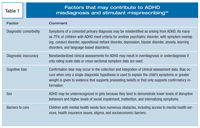
In addition, stimulant prescription rates vary by sex and age. ADHD diagnostic rates and stimulant treatment rates are higher in boys than in girls younger than 20 years.9 Rates of stimulant treatment are highest among boys aged 12 years and girls aged 11 years, and they decline with age.14 The National Survey of Children’s Health showed that the factors associated with medication treatment for ADHD included younger age, the burden of impairment from symptoms, and a recent health care contact.5 Some factors associated with possible ADHD misdiagnosis and stimulant misprescribing are listed inTable 1.
Simple pronouncements of the overmedication of youth with ADHD based on temporal trends in the absolute rate of rise of stimulant quota production and stimulant prescriptions cannot be supported. The majority of the literature published to date does not support the general idea that ADHD is overdiagnosed nor does it support the idea that stimulants are overprescribed in children and adolescents in the United States. However, the data also suggest that there continue to be geographic areas of stimulant overprescribing or inappropriate prescribing.
What is already known about overdiagnosis and overprescribing in ADHD?
? ADHD is the most extensively studied pediatric mental health disorder, yet controversy and public debate over the diagnosis and medication treatment of the disorder continue. Questions and concerns continue to be raised by professionals, media commentators, and the public about the possibility that ADHD is overdiagnosed in youths and that stimulants are overprescribed.
What new information does this article provide?
? This article reviews what is known about the prevalence of ADHD and stimulant prescribing rates in children and adolescents in the United States. While the data do not suggest a general problem with ADHD overdiagnosis and stimulant overprescribing, there continues to be variability in diagnosis and prescribing rates. Reasons for the continued controversy include fears of stimulant abuse and diversion, physician overprescribing, limited managed care carve-out payer resources to support evidence-based standards of ADHD evaluation and treatment, and continuing unease as to the legitimacy of the ADHD diagnosis.
What are the implications for psychiatric practice?
? Comprehensive physician ADHD evaluation practices are essential for accomplishing evidence-based stimulant prescribing and for reducing unwanted variation in stimulant prescribing rates. This, in turn, should help reassure the public that management is accomplished consistently and with due expertise.
Stimulant abuse and diversion
Despite more than 250 randomized controlled medication trials attesting to the efficacy and safety of stimulant use in patients with ADHD, there continues to be controversy, especially regarding abuse and diversion. It is important to distinguish between these issues. Stimulant abuse refers to the continued use of a drug that leads to significant impairment in daily functioning characterized by recurrent use under hazardous conditions, such as while driving an automobile or operating machinery, and by legal and interpersonal problems.16 Diversion is the practice by which legitimate stimulant prescriptions for ADHD are diverted for reasons other than treating ADHD.17
Methylphenidate and amphetamine used to treat the core ADHD symptoms of inattention, impulsivity, and hyperactivity have an established potential for abuse. Preclinical and clinical studies show that both types of stimulants have reinforcing effects that are similar to each other and to drugs of abuse, such as cocaine.16,18 Findings from a study by Biederman and colleagues19 indicate that a diagnosis of ADHD increases the risk of early-onset substance use disorders that have an aggressive course. These data suggest a potential relationship between ADHD, stimulant treatment, and later substance use disorders.
However, despite the established abuse potential of stimulants, the evidence that methylphenidate and amphetamine are readily abused in the ADHD population in the formulations and doses used clinically is limited.16 Rather than abusing stimulants, patients with ADHD frequently take less medication than prescribed.20 The reinforcing effects of stimulants in ADHD patients may be associated more with clinical efficacy than with abuse liability.
Neuroimaging research demonstrates both pharmacokinetic and pharmacodynamic differences in the euphoric and abuse liability effects of methylphenidate and cocaine in humans.21 Agents such as cocaine that demonstrate rapid absorption and rapid turnover at CNS synaptic dopamine receptors are associated with euphoric and abuse liability effects. The same rapid changes in drug concentration can be achieved through intranasal or intravenous, rather than oral, immediate-release (IR) stimulants. Drugs such as oral methylphenidate demonstrate slower absorption and longer temporal CNS dopamine receptor binding and release properties and are associated more with therapeutic effects than with abuse liability effects.
The drug release technology of long-acting stimulants that have a beaded or osmotic release mechanism or that are covalently bonded to an amino acid that mimics the pharmacokinetic properties of IR methylphenidate or IR amphetamine given 2 or 3 times daily makes intranasal and intravenous use difficult.17 Thus, while stimulants have properties consistent with abuse liability, their clinical use in ADHD patients does not suggest widespread abuse.
Stimulants are not without some abuse risk in clinical populations. Abuse rates rise in persons with ADHD comorbid with substance use disorders and/or other disruptive behavior diagnoses, such as oppositional defiant disorder and conduct disorder.22 Coexisting bipolar disorder increases the risk of stimulant abuse. A family history of substance use disorders increases risk. In such cases, careful monitoring and follow-up are recommended.
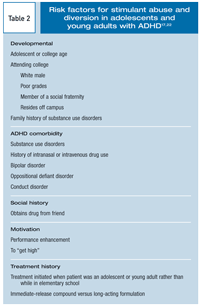
A more pressing and prevalent issue than abuse appears to be diversion of legitimately prescribed stimulants to individuals without ADHD for purposes other than to treat ADHD or narcolepsy. The results of a meta-analysis involving more than 113,000 patients showed rates of past year nonprescribed stimulant use between 5% and 9% in adolescents and between 5% and 35% in college students.17 Risk factors for stimulant abuse and diversion are shown in Table 2.
When prescribing stimulants for adolescents or college students with ADHD, a detailed discussion of stimulant diversion, abuse, and medication misuse with the patient and his or her parents is important. Teach the patient how to store the medication safely when he is living away from home.
Diagnosis and treatment
Evaluation of the patient with ADHD takes time and should include a multi-informant, multi-method, developmental assessment of symptoms, impairment, course of illness, previous assessments and treatments, school and social functioning, and comorbid conditions.23,24 The evaluation process is essentially a time-consuming cognitive endeavor of pattern matching the patient’s symptoms and disease course with what is known about the natural history of ADHD and hypothesis testing and integrating all available data. This systematic evaluation establishes that all clinical criteria for an ADHD diagnosis are met.
Faced with severe payer and clinical time constraints, many physicians diagnose ADHD by emphasizing a present oriented, cross-sectional symptom evaluation.6,25 This type of evaluation may result in overdiagnosing ADHD, or underidentifying ADHD in children with complex and comorbid presentations. A quick cursory evaluation from a too busy physician reinforces the public’s perception that stimulant medications with abuse potential are too readily prescribed for children who do not meet full diagnostic criteria for ADHD.
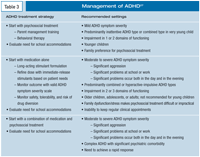
Once the diagnosis of ADHD is established, treatment planning depends on symptom severity and pervasiveness of functional impairment, tempered by the wishes and concerns of the patient and his family. Treatment should be individualized for each patient. Not all children with ADHD require medication. Behavioral therapy can be helpful for many. Patients with very mild ADHD may initially receive psychosocial ther-apy and educational support without medications.
Table 3 outlines an ADHD disease management strategy based on symptom severity and impairment.
Conclusions
Continued controversy over whether ADHD is overdiagnosed and stimulants overprescribed despite much scientific data to the contrary reflects ongoing public discomfort about ADHD as a valid and legitimate disorder. For example, the public perceives that children and adults with a medical disorder should look and act sick, whereas many of the core ADHD symptoms are seen in lively, willful, and exuberant persons. Moreover, the general perception is that medications prescribed to treat illness (ie, antibiotics) are supposed to act differently in sick persons than in healthy individuals and that stimulants work the same way in children and adults to enhance sustained vigilance whether they have a diagnosis of ADHD or not. Furthermore, the definition of ADHD seems to change frequently. If the definition of ADHD keeps changing, is it a genuine medical disorder?
Despite overwhelming scientific evidence of the legitimacy of ADHD as a CNS neurobiological disorder, the general public appears confused about ADHD: is it a medical illness, a psychiatric syndrome, a mental disorder, a behavioral health disorder, a behavioral problem, a motivational problem, or a school-based learning and socialization problem?1,7,8 Doubt and confusion as to where this disorder fits into the general spectrum of illness further feeds the general perception that ADHD is a socially constructed disorder rather than a valid neurobiological disorder. This increases the public’s concern that ADHD is overdiagnosed and stimulants are overprescribed.
The public’s fear that ADHD is overdiagnosed and that stimulants are overprescribed is not generally supported by the current scientific research. Reasons for the continued controversy include fears of stimulant abuse and diversion, physician overprescribing, limited payer resources to support evidence-based standards of ADHD evaluation and treatment, and continuing unease as to the legitimacy of the ADHD diagnosis. Comprehensive physician ADHD evaluation practices are essential to accomplishing evidence-based stimulant prescribing and to reduce unwanted variation in stimulant prescribing rates that should, in turn, reassure the public that management is accomplished consistently and with due expertise.
References:
References
1. Goldman L, Genel M, Bezman R, Slanetz PJ. Diagnosis and treatment of attention-deficit/hyperactivity disorder in children and adolescents. Council on Scientific Affairs, American Medical Association. JAMA. 1998;279:1100-1107.
2. LeFever GB, Arcona AP, Antonuccio DO. ADHD among American schoolchildren: evidence of overdiagnosis and overuse of medication. Sci Rev Ment Health Pract. 2003;2:49-60.
3. Safer DJ, Malever M. Stimulant treatment in Maryland public schools. Pediatrics. 2000;106:533-539.
4. Safer DJ, Zito JM, Fine EM. Increased methylphenidate usage for attention deficit disorder in the 1990s. Pediatrics. 1996;98(6, pt 1):1084-1088.
5. Visser SN, Lesesne CA, Perou R. National estimates and factors associated with medication treatment for childhood attention-deficit/hyperactivity disorder. Pediatrics. 2007;119(suppl 1):S99-S106.
6. Mayes R, Bagwell C, Erkulwater J. ADHD and the rise in stimulant use among children. Harvard Rev Psychiatry. 2008;16:151-166.
7. Barkley RA. Attention-Deficit Hyperactivity Disorder: A Handbook for Diagnosis and Treatment. 3rd ed. New York: Guilford Press; 2006.
8. Solanto MV. Neuropsychopharmacological mechanisms of stimulant drug action in attention-deficit hyperactivity disorder: a review and integration. Behav Brain Res. 1998;94:127-152.
9. Castle L, Aubert RE, Verbrugge RR, et al. Trends in medication treatment for ADHD. J Atten Disord. 2007;10:335-342.
10. Olfson M, Marcus SC, Weissman MM, Jensen PS. National trends in the use of psychotropic medications by children. J Am Acad Child Adolesc Psychiatry. 2002;41:514-521.
11. Vitiello B, Zuvekas SH, Norquist GS. National estimates of antidepressant medication use among U.S. children, 1997-2002. J Am Acad Child Adolesc Psychiatry. 2006;45:271-279.
12. Drug Enforcement Administration, US Department of Justice. Controlled Substances: Proposed Aggregate Production Quotas for 2008. http://www.deadiversion.usdoj.gov/fed_regs/quotas/2008/fr1107.htm. Accessed July 7, 2011.
13. Merikangas KR, He JP, Brody D, et al. Prevalence and treatment of mental disorders among US children in the 2001-2004 NHANES. Pediatrics. 2010;125:75-81.
14. Centers for Disease Control and Prevention. Mental health in the United States. Prevalence of diagnosis and medication treatment for attention-deficit/hyperactivity disorder-2003. MMWR. 2005;54:842-847.
15. Angold A, Erkanli A, Egger HL, Costello EJ. Stimulant treatment for children: a community perspective. J Am Acad Child Adolesc Psychiatry. 2000;39:975-984.
16. Kollins SH. Abuse liability of medications used to treat attention-deficit/hyperactivity disorder (ADHD). Am J Addict. 2007;16(suppl 1):35-42; quiz 43-44.
17. Wilens TE, Adler LA, Adams J, et al. Misuse and diversion of stimulants prescribed for ADHD: a systematic review of the literature. J Am Acad Child Adolesc Psychiatry. 2008;47:21-31.
18. Kollins SH. A qualitative review of issues arising in the use of psycho-stimulant medications in patients with ADHD and co-morbid substance use disorders. Curr Med Res Opin. 2008;24:1345-1357.
19. Biederman J, Monuteaux MC, Mick E, et al. Young adult outcome of attention deficit hyperactivity disorder: a controlled 10-year follow-up study. Psychol Med. 2006;36:167-179.
20. Pappadopulos E, Jensen PS, Chait AR, et al. Medication adherence in the MTA: saliva methylphenidate samples versus parent report and mediating effect of concomitant behavioral treatment. J Am Acad Child Adolesc Psychiatry. 2009;48:501-510.
21. Volkow ND, Ding YS, Fowler JS, et al. Is methylphenidate like cocaine? Studies on their pharmacokinetics and distribution in the human brain. Arch Gen Psychiatry. 1995;52:456-463.
22. Kollins SH. ADHD, substance use disorders, and psychostimulant treatment: current literature and treatment guidelines. J Atten Disord. 2008;12:115-125.
23. Dulcan M. Practice parameters for the assessment and treatment of children, adolescents, and adults with of attention-deficit/hyperactivity disorder. American Academy of Child Adolescent Psychiatry. J Am Acad Child Adolesc Psychiatry. 1997;36(10 suppl):85S-121S.
24. King RA. Practice parameters for the psychiatric assessment of children and adolescents. American Academy of Child Adolescent Psychiatry. J Am Acad Child Adolesc Psychiatry. 1997;36(10 suppl):4S-20S.
25. Bridges J, Fitzgerald L, Meyer J. New workforce roles in health care: exploring the longer-term journey of organisational innovations. J Health Organ Manag. 2007;21:381-392.
26. Sciutto MJ, Eisenberg M. Evaluating the evidence for and against the overdiagnosis of ADHD. J Atten Disord. 2007;11:106-113.
27. Conners CK, March JS, Francis A, et al. Treatment of attention-deficit/hyperactivity disorder: expert consensus guidelines. J Atten Disord. 2001;4(suppl 1):S1-S128.
























